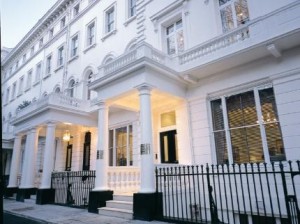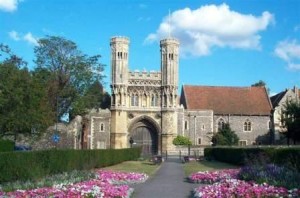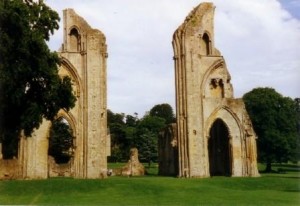
Fountains Abbey - © Klaus
Studley Royal Park & Fountains Abbey have been an established World Heritage Site (WHS) since 1986. The estate is located in Yorkshire and offers visitors the chance to visit a historic estate filled with character. Offering ten historic buildings to explore in wonderful surroundings the site is a popular one. The site has great historical, architectural and cultural significance offering visitors a fascinating insight to the period of history it is associated with. The impressive water gardens, ruins and historic surroundings combine to highlight the importance of the estate and the contribution it has made to a number of areas, making it an interesting place to visit.
Overview
Studley Royal Park including the ruins of Fountains Abbey are located close to Ripon in North Yorkshire. The landscape here is striking with a number of features that mean the site is of outstanding significance and value. There is 18th century landscaping evident here along with the neo-Gothic castle of Studley Royal Park and 19th century vistas and plantations. The estate here is provides visitors with a range of contrasts including a stunning Georgian water garden and the largest abbey ruins in the UK.
The estate offers an enjoyable day out for the whole family with plenty to see and do. There is plenty of open space to enjoy a beautiful walk and explore the ten buildings filled with history and character. The estate has a history that spreads for approx 800 years.
The estate is some 822 acres in size and is owned by the National Trust and is considered to be of great historic, aesthetic and cultural importance. The estate is among the most popular paid for attractions in the UK managed the National Trust.
The Abbey is the largest monastic ruin in the UK, it was founded in back in 1132 by Benedictine monks. The Abbey ruins provide evidence of one of the few surviving Cistercian houses from the 12th century offering a great insight in to a religious building. The Abbey ruins provide a dramatic sight for visitors, set in an inspiring setting with lawn and cliff faces on either side and the River Skell running under the Abbey, the setting is spectacular. The Abbey highlights great architecture from the 12th Century and offers visitors the chance to see a unique building and take in the atmosphere here.
The Studley Royal Estate was at one time a separate estate from Fountains Abbey. However from 1767 William Aislabie son of John Aislabie who has previously inherited the estate in 1693, bought the Abbey ruins and made it one estate.
Visitors can take part in a number of interesting walks on the estate along with guided tours that give visitors further information and insight to the history and culture of site. The site also hosts a number of evening events these include theatre, opera, concerts and firework displays. With plenty going on and so much to see and experience visitors have a number of options.
Studley Royal's importance lies in the fact it has remained mainly in its original form highlighting a great example of an 18th century green garden. The impressive water garden and landscaping here are thought to have influenced garden throughout Europe. The garden also contains lawns, ponds, canals, cascades, hedges and statues among others and is designed around the natural environment giving visitors the impression of visiting a garden at home in its natural surroundings.
Fountains Hall is a Jacobean building that is located in the estate and provides a wonderful example of a building that is associated with this period in history. The building has been partly built with stone from the Abbey, the building also boasts a formal garden and over the years that been changed to allow it to be used for several uses. There are 3 rooms that visitors can see, the Arkell room that is used for exhibitions, the Reading room that includes chairs to sit in and the Stone Hall. The National Trust has made the Fountains Hall one if its main restoration projects since the early 1980s. There are now two apartments where visitors can stay in the actual Fountains Hall. The apartments named Proctor and Vyner offer visitors the chance to really experience staying at this great historic building.
St. Mary’s Church is an Anglican church that offers a wonderful example of High Victorian Gothic architecture. Considered one of the finest designs of William Burges, the church was commissioned in 1871. The building has been integrated in to the surrounding landscape and environment, the church has a decorated interior associated with the period. The interior is striking with the sanctuary and chancel well decorated with angels and lions. The organ case resembles a medieval house and there are carved parrots in many colours located above the choir stalls. In 1878 the church was consecrated. The church is open to visitors from April to September.
The Deer Park is home to 500 wild deer. Three breeds of deer live in the Deer Park: Red, Fallow and Sika. The rutting season takes place from approx September through to November. The park provides visitors with a great place to enjoy scenic walks where you can take in the surroundings and pleasant environment.
The World Heritage Site status stipulates the site must be preserved and protected and there is much preservation and conversation work taking place here to ensure the site is still here to be enjoyed and appreciated by future generations.
How To Get There
By Car:
If travelling from the A1 turn off at the A61 signposted for Ripon then take the A6108 & B6265, follow the brown signs for Fountains Abbey.
There is free parking available at the Visitor Centre. Studley Royal Car Park has a charge of approx £3. There is priority disabled parking available at Westgate.
By Train: The closest town Ripon (4 miles away) does not have a rail station. The stations at Leeds, York and Harrogate offer bus links to Ripon from the stations.
By Bus:
Harrogate District Community Transport with the Ripon Roweller No. 139 from Ripon to Markington takes visitors to the estate.
By Coach: National Express offers a number of routes to Ripon from major cities such as London, Leeds, Manchester and Liverpool.
By Foot:
From Ripon the distance to the estate is 4 miles, this can be walked by using the public footpaths and bridleways
Contact Details
Address:
Fountains Abbey & Studley Royal Water Garden
Ripon Nr Harrogate
North Yorkshire, UK
HG4 3DY
Telephone: +44 (0)1765 608888
Fax: +44 (0)1952 435 999
Website: Fountains Abbey & Studley Royal Park
Facilities and Information
Facilities:
There is a visitor centre restaurant that uses local and seasonal produce. There are a range of drinks and refreshments along with snacks and hot meals served too. There is also soup, cakes, biscuits and more on offer, along with a menu for children
There is a Children’s play area situated between the Visitor Centre and the Abbey.
The Studley Tearoom serves coffee, snacks and afternoon tea. Visitors can enjoy some cake and afternoon tea after a relaxing walk on the grounds of the estate. There is also local ice cream from Yorkshire to try for visitors. The tea room offers great views of Studley Lake making for nice surroundings in which to relax and enjoy a break.
Opening Times:
Fountains Abbey and Studley Royal Estate:
On Fridays in November, December and January the estate is closed. The Deer Park remains open.
Fountains Abbey, Hall, Mill, Shop and the Water Garden:
From November until February 10.00am to 16.00
From March to October 10.00am to 17.00
Deer Park:
Is Open Daily during the daylight hours. Note: Car Park charge of £3.
St Mary's Church:
Open daily from April to end of September from 12.00 to 16.00.
Further Information:
Admission Prices:
Adult: £8.00 approx
Children: £4.20 approx
Family ticket: £21.00 approx
Map
View Larger Map
For Local Search and Directions see: Fountains Abbey & Studley Royal Park Map
Tips & Other Considerations
There may be some variations on the opening hours depending on the time of year and other factors. Visitors are advised to double check before going to ensure any attractions and place of interest is open and avoid disappointment.
When travelling always remain alert and aware of your surroundings and environment. Ensure your belongings especially your wallet/purse and valuables are hidden away from public view (particularly at tourist attractions & places with crowds). If you have a bag try to use a shoulder bag with a good quality, strong strap, that is put across your shoulder not on your shoulder making it more difficult for anyone to take your bag.
If you are travelling by car to the estate and the WHS area ensure you are well prepared with maps and Sat Nav to aid your journey, particularly if you are not familiar with the local area and roads. For door to door directions for car and public transport journeys use the journey planner for further details.
If you are looking for local car parking, ensure you fully understand the rules, regulations & charges for car parks and street parking. The parking rules can be complex if you are not sure it is wise not to park there.
If you are travelling by public transport, it is useful to check for service updates prior to beginning your journey for any delays, disruption or cancellations to services that may impact on your journey. Ensure you have the service timetables for the trains, trams, buses and coaches. Remember when the last services are and ensure you make it to the train/bus/coach stops well in time to avoid missing the service.
Disclaimer: The information given in on this website is given in good faith and to the best of our knowledge. If there are any discrepancies in no way do we intend to mislead. Important travel details and arrangements should be confirmed and verified with the relevant authorities.




